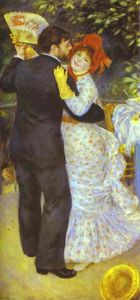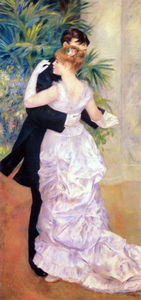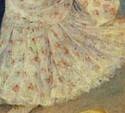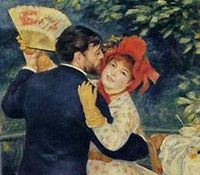Dance in the Country Story-Theme
- Date of Creation:
- 1883
- Alternative Names:
- The Country Dance / La danse a la champagne
- Height (cm):
- 180.00
- Length (cm):
- 90.00
- Medium:
- Oil
- Support:
- Canvas
- Subject:
- Figure
- Framed:
- No
- Art Movement:
- Impressionism
- Created by:
- Current Location:
- Paris, France
- Displayed at:
- Musee dÓrsay
- Owner:
- Musee dÓrsay
- Dance in the Country Story-Theme Page's Content
- Introduction
- Story and Theme
Introduction
Dance in the Country is also known as The Country Dance and La danse à la champagne. It was part of a set of three paintings; La danse à la ville, La danse à Bougival, and La danse à la champagne commissioned by Paul Durand-Ruel, one of Renoir's greatest supporters, in 1883.
Dance in the Country Story and Theme
This Dance collection marked a change in Renoir's technique in the early 1880s and it went on to influence his art throughout the rest of that decade, which proved to be the most experimental of his career.
It was following his trip to Italy and exposure to the works of artists such as Raphael that Renoir decided to experiment with his technique. In a letter written upon returning home he said: "I will, I think, attain the grandeur and simplicity of the ancient painters [... ] so as a result of seeing the outside, I ended up seeing nothing but the great harmonies without taking any more notice of the petty details which extinguish the sun instead of making it burn brighter. "
One outcome of assessing his work was that Renoir began to paint women in more prominent positions in his art. In his series of Dance paintings he emphasized each of the females and the viewer's eye is very much drawn towards the couple.
Renoir's biographers claim that he worked best when surrounded by women, as he could listen to them sing while painting. It appears that his canvases and yearning for the company of women were suggestive of his general attitude towards the opposite sex, and for him women could serve as muses.
Dance in the Country is an inviting painting that grabs the viewer's attention. The woman's smiling face - modeled by Aline Charigot, Renoir's future wife - invites the observer to join this pleasant scene. It seems that Renoir begins to show more respect for the woman portrayed and allows her to smile. At the time Renoir created this canvas, it was generally believed that portraying models with a smile would result in a painting not being taken seriously.
It was only in this particular canvas that Renoir painted the female - his future wife - enjoying herself and showing a full smile. Renoir revealed some years later to his son that his mother was a wonderful dancer: "Your mother waltzed divinely. I'm afraid I stepped all over her feet".
Renoir's depiction of his wife contrasts to that of Suzanne Valadon in La danse à la ville. Renoir's mistrust of knowledgeable women was renowned and so it may have been the case that he felt at ease with Aline Charigot, as she was a seamstress and a working class girl. Aline did not threaten Renoir's reputation and thus he allowed her to be happy and enjoy dancing with a smiling mouth.
In his first sketch of Dance in the Country there is very little detail and the woman's identity is unknown. Yet, in the final painting Renoir depicts a very happy woman with a mouth curving upwards in a definite smile. She is the only woman in this series with an open mouth with teeth shining through.
Dance in the Country followed La danse à la ville but was a fairly different painting, despite depicting the same theme. Renoir used models for his life-sized series with couples, and used these paintings to show distinct social dancing situations. Unlike La danse à la ville, the couple in Dance in the Country dance outside on grass in a less glamorous setting. The couple is framed by the background vegetation.
As a middle-aged man, Renoir was content in his private life and he had a stable income for the first time. Feeling more settled, Renoir dedicated much time to his family and his happiness was evident in his art. He also became more bourgeois and his collection of Dance pictures are celebrations of this treasured middle-class pastime.
Dance in the Country suggests a bourgeoisie couple having just finished dinner rising from their chairs spontaneously to dance to a familiar song, and their spontaneity is emphasized by the hat dropped in the foreground. Movement is portrayed through the couple's body language and clothing, and it seems the dancers are immersed in their own thoughts and space.
Renoir painted Dance in the Country with great detail in order to add meaning to this scene and it is a truly joyful depiction. Features such as the ice-cream, the half-full glass and the outline of a person in the background all serve as a reminder that this scene takes place in public.
The folds of Aline's gown follow her every move, and Renoir drew every last detail. Dance in the Country is both romantic and energetic, making this piece one of Renoir's most treasured paintings.





